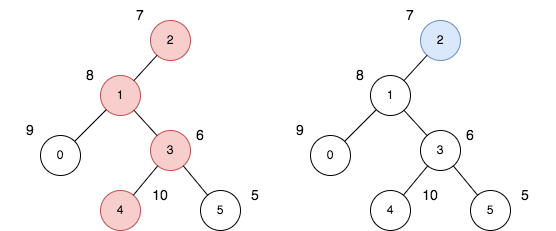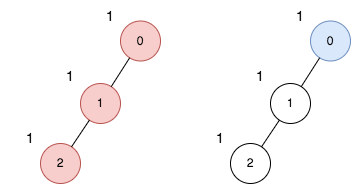最大价值和与最小价值和的差值
难度:
标签:
题目描述
There exists an undirected and initially unrooted tree with n nodes indexed from 0 to n - 1. You are given the integer n and a 2D integer array edges of length n - 1, where edges[i] = [ai, bi] indicates that there is an edge between nodes ai and bi in the tree.
Each node has an associated price. You are given an integer array price, where price[i] is the price of the ith node.
The price sum of a given path is the sum of the prices of all nodes lying on that path.
The tree can be rooted at any node root of your choice. The incurred cost after choosing root is the difference between the maximum and minimum price sum amongst all paths starting at root.
Return the maximum possible cost amongst all possible root choices.
Example 1:

Input: n = 6, edges = [[0,1],[1,2],[1,3],[3,4],[3,5]], price = [9,8,7,6,10,5] Output: 24 Explanation: The diagram above denotes the tree after rooting it at node 2. The first part (colored in red) shows the path with the maximum price sum. The second part (colored in blue) shows the path with the minimum price sum. - The first path contains nodes [2,1,3,4]: the prices are [7,8,6,10], and the sum of the prices is 31. - The second path contains the node [2] with the price [7]. The difference between the maximum and minimum price sum is 24. It can be proved that 24 is the maximum cost.
Example 2:

Input: n = 3, edges = [[0,1],[1,2]], price = [1,1,1] Output: 2 Explanation: The diagram above denotes the tree after rooting it at node 0. The first part (colored in red) shows the path with the maximum price sum. The second part (colored in blue) shows the path with the minimum price sum. - The first path contains nodes [0,1,2]: the prices are [1,1,1], and the sum of the prices is 3. - The second path contains node [0] with a price [1]. The difference between the maximum and minimum price sum is 2. It can be proved that 2 is the maximum cost.
Constraints:
1 <= n <= 105edges.length == n - 10 <= ai, bi <= n - 1edgesrepresents a valid tree.price.length == n1 <= price[i] <= 105
代码结果
运行时间: 296 ms, 内存: 49.1 MB
/*
题目思路:
1. 使用Java Stream API来处理节点及边的数据。
2. 使用递归函数与Stream结合计算每个节点作为根的最大路径和和最小路径和。
3. 使用Stream计算并获取所有可能根节点中的最大差值。
*/
import java.util.*;
import java.util.stream.*;
public class Solution {
private int[] prices;
private List<Integer>[] tree;
public int maxCost(int n, int[][] edges, int[] price) {
this.prices = price;
this.tree = Stream.generate(ArrayList<Integer>::new).limit(n).toArray(ArrayList[]::new);
Arrays.stream(edges).forEach(edge -> {
tree[edge[0]].add(edge[1]);
tree[edge[1]].add(edge[0]);
});
return IntStream.range(0, n)
.map(i -> {
boolean[] visited = new boolean[n];
int[] maxMin = dfs(i, visited);
return maxMin[0] - maxMin[1];
})
.max().orElse(0);
}
private int[] dfs(int root, boolean[] visited) {
visited[root] = true;
int maxSum = prices[root];
int minSum = prices[root];
for (int neighbor : tree[root]) {
if (!visited[neighbor]) {
int[] childMaxMin = dfs(neighbor, visited);
maxSum = Math.max(maxSum, prices[root] + childMaxMin[0]);
minSum = Math.min(minSum, childMaxMin[1]);
}
}
return new int[] { maxSum, minSum };
}
}
解释
方法:
时间复杂度:
空间复杂度: